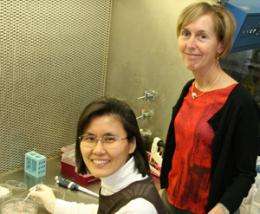Disruption of nerve cell supply chain may contribute to Parkinson's

(Medical Xpress) -- New data offer hints to why Parkinson's disease so selectively harms brain cells that produce the chemical dopamine, say researchers at Washington University School of Medicine in St. Louis.
Dopamine is involved in brain cell communications including the signals that control movement. As Parkinson's kills the dopamine-producing cells, patients begin to develop tremors, problems moving and other symptoms.
The new research shows that a drug known to damage dopamine-producing nerve cells and mimic Parkinson's disease does so by rapidly damaging cellular energy generators called mitochondria. This damage impairs the ability of mitochondria to circulate around the cell as they normally would. As a result, axons, the extended arms nerve cells use to send messages, wither; a few days later, the body or main portion of the cell also dies.
"Much of the research into Parkinson's disease treatments is focused on saving the bodies of these cells, but our results suggest that keeping axons healthy also is essential,"says Karen O'Malley, PhD, of Washington University School of Medicine in St. Louis. "When axons die back, dopamine is no longer delivered to the neurons that need it. The cell body also has fewer connections to other cells, and it needs those connections to survive."
The results were published May 11 in The Journal of Neuroscience.
Many processes and facilities for cellular maintenance are in the body of the nerve cell, and their products sometimes have to travel a significant distance to reach the axon's end.
"If you think, for example, about one of your peripheral nerves, the cell body is located in the spinal column, but some of the axons extend as far as your big toe," says O'Malley, professor of neurobiology. "That's like the cell body sits in an office in St. Louis and the end of the axon is in Chicago."
O'Malley compares the axon's system for transporting supplies to a railroad. Mitochondria are part of the railroad's cargo. They supply the energy that allows the axon to do its work.
For the study, O'Malley gave cultured mouse nerve cells a toxin called MPP+ that causes Parkinson's-like symptoms.
"MPP+ is a derivative of a synthetic form of heroin developed in California in the early 1980s," O'Malley says. "It came to scientists' attention when teenage abusers of the drug went to the hospital with Parkinson's disease symptoms."
O'Malley found that the toxin stopped the movement of mitochondria in the axon in 30 minutes. The railroad still functioned, shipping other cargo to the end of the axon. But most mitochondria either stopped moving or were headed for the cell body instead of the axon.
O'Malley suspected that this meant the mitochondria were damaged by the changes caused by the toxin and being shipped back to the cell body for repair. Additional tests supported this theory, showing that the mitochondria had lost their ability to maintain their membrane potential, a measure of mitochondrial fitness.
The specificity of this toxin for dopamine-producing cells is reinforced by the finding that other types of nerve cells did not have problems transporting mitochondria after toxin exposure. In a comparison between different nerve cell types, O'Malley found mitochondria in dopamine-producing nerve cells are smaller in size and travel three times slower. But she can't yet definitively say that these distinctions play a role in the problems caused by the toxin.
Scientists screened several compounds to see if they could block the toxin's effects. Only two antioxidants worked, glutathione and N-acetyl cysteine. The latter compound has already been shown to be effective in animal models of Parkinson's disease and is used as a treatment for other disorders in patients.
O'Malley is currently studying whether two genes linked to Parkinson's disease affect mitochondria damaged by the toxin.
"We're going to continue to look for specific differences in these cells that might help scientists develop better treatments," O'Malley says.
More information: Kim-Han JS, Antenor-Dorsey JA, O'Malley KL. The Parkinsonian mimetic, MPP+, specifically impairs mitochondrial transport in dopamine axons. The Journal of Neuroscience, May 11, 2011.














